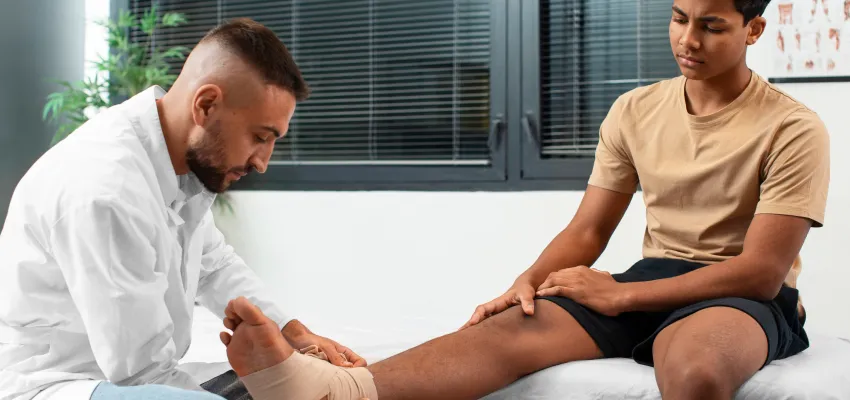How to Prevent Sports Injuries: Tips from Orthopedic Experts

Stay in the game longer by training smarter, not just harder
Whether you're a weekend warrior, a fitness enthusiast, or a competitive athlete, sports injuries can be a major setback — physically, mentally, and emotionally. From sprains and strains to more serious ligament tears and fractures, these injuries often result from avoidable mistakes: poor form, overtraining, inadequate warm-ups, or ignoring early warning signs.
Orthopedic experts agree — prevention is the best medicine. With a proactive approach, you can significantly reduce your injury risk while enhancing performance and longevity.
Here's a deep dive into science-backed, expert-approved strategies to help you stay strong, mobile, and injury-free.
1. Prioritize Proper Warm-Up & Cool-Down Routines
“Cold muscles are tight muscles — and tight muscles tear.”
One of the most overlooked causes of sports injuries is insufficient warm-up. Skipping this step leaves muscles and joints unprepared for the physical demands of sport, making them more vulnerable to tears, strains, and inflammation.
✔️ What Orthopedic Experts Recommend:
- Dynamic Warm-Ups: Focus on movements that raise your core temperature and mimic the activity (e.g., arm circles, leg swings, high knees).
- Joint Mobilization: Loosen the hips, shoulders, and ankles — especially for explosive sports like basketball or soccer.
- Post-Workout Cool Down: Include static stretching and light movement to prevent muscle stiffness and improve flexibility.
🕒 Tip: Spend 5–10 minutes warming up and at least 5 minutes cooling down after every session.
2. Build Functional Strength & Stability
“Strong muscles support stable joints.”
Orthopedic doctors emphasize that injury prevention starts with strong, well-balanced muscles. This includes both the major movers and the smaller stabilizers often neglected in training.
✔️ What to Include:
- Strength Training: Focus on compound movements (squats, lunges, deadlifts, pull-ups) to build total-body strength.
- Stabilization Work: Include exercises like single-leg deadlifts, side planks, and balance board drills to enhance proprioception.
- Core Training: A strong core reduces pressure on the spine and improves posture — a major injury risk factor.
⚖️ Don't forget muscle balance. Train both front and back body (quads vs. hamstrings, chest vs. back) to avoid imbalances that lead to injury.
3. Practice Good Technique & Body Mechanics
“It's not what you do — it's how you do it.”
Using incorrect form during training or play is a leading cause of overuse injuries like tendonitis, shin splints, and stress fractures. Orthopedic experts stress the importance of movement quality over quantity.
✔️ Best Practices:
- Get coached: Work with a qualified trainer or physiotherapist to correct movement patterns.
- Train slowly before going fast: Master mechanics before adding speed or resistance.
- Check posture regularly: Poor alignment increases strain on joints, especially knees, shoulders, and spine.
🎥 Consider video analysis to review your technique during complex lifts or sport-specific drills.
4. Don't Underestimate Recovery & Rest
“Your body gets stronger during rest, not just training.”
Injury risk skyrockets when your body doesn't have time to recover. According to sports orthopedists, microtears from intense activity need time to heal. Without recovery, they can become full-blown injuries.
✔️ Recovery Tips:
- Sleep 7–9 hours/night to allow tissue repair and hormone regulation.
- Take scheduled rest days, especially after high-intensity or impact-heavy workouts.
- Use recovery tools like foam rollers, massage guns, and compression gear to reduce muscle soreness and improve circulation.
🚨 Ignoring small aches? That's how small problems become major injuries.
5. 💧 Stay Hydrated & Fuel Properly
“Joint health and tissue resilience start from the inside.”
What you eat and drink directly affects how your muscles, joints, and connective tissues function. Dehydration, nutrient deficiency, or under-fueling can make you more prone to cramping, muscle pulls, and joint pain.
✔️ Nutrition & Hydration Guidelines:
- Hydrate before, during, and after activity to prevent cramps and joint stiffness.
- Prioritize protein to support muscle recovery and repair.
- Include anti-inflammatory foods (omega-3s, leafy greens, turmeric) to reduce tissue stress.
- Electrolyte balance: Especially in endurance or high-sweat sports, replace sodium, potassium, and magnesium lost through sweat.
🥗 Pre- and post-workout meals matter! Fuel up with complex carbs and lean protein for optimal performance and recovery.
6.Listen to Your Body
“Pain is a signal — not something to push through.”
Perhaps the most important advice from orthopedic experts is simple: respect your body's signals. Many athletes make the mistake of training through pain or ignoring tightness, only to face serious injuries later.
✔️ What to Watch:
- Sudden or sharp pain
- Persistent soreness or stiffness
- Swelling or instability in a joint
- Decreased range of motion
When in doubt, consult a sports physiotherapist or orthopedic specialist before returning to activity.
🧠 Bonus Tip: Get Regular Screenings
Orthopedic experts also recommend movement screenings and joint assessments — especially if you're returning to sport after injury, or if you're over 35. These evaluations can identify:
- Muscle imbalances
- Joint instability
- Mobility restrictions
- Risky movement patterns
With early intervention, many injuries can be prevented before they happen.
🏁 Final Thoughts
Whether you're hitting the gym, the track, or the field, injury prevention is just as important as performance training. Following these orthopedic-approved strategies — from warm-ups and strength training to recovery and proper fueling — can help you build a resilient body that not only performs better but stays injury-free.
Remember: You don't have to be sidelined to start caring about injury prevention.
Start now, train smart, and keep moving — safely.
✔️ Summary: Injury Prevention Checklist
- Always warm up dynamically and cool down properly
- Build functional strength and joint stability
- Prioritize correct technique and body alignment
- Don't skip rest and recovery — especially sleep
- Eat, hydrate, and fuel your performance
- Listen to your body's early warning signs

